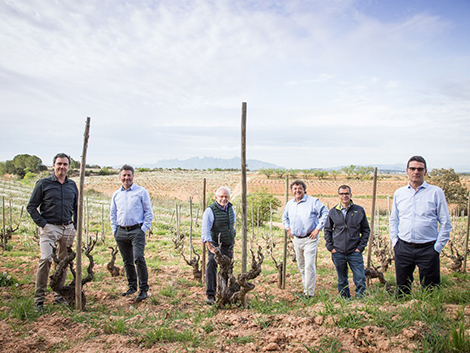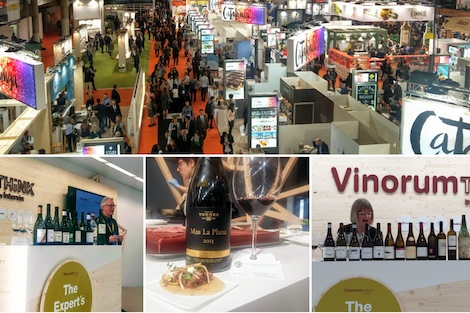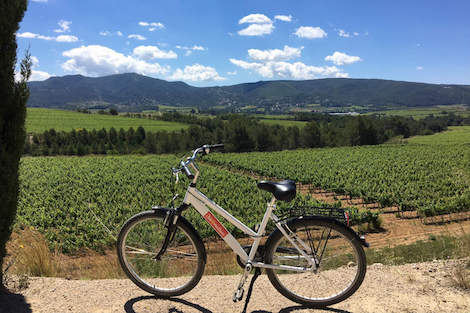
Gramona, Llopart, Nadal, Recaredo, Sabaté i Coca and Torelló are the six producers behind Corpinnat, a new EU-registered brand that sets up a private certification for sparkling wines in Penedès. The move comes after the inaction of Cava’s Regulatory Board to set demarcate areas in an appellation whose boundaries do not match a specific territory —although 95% of Cava is produced in Penedès, the appellation includes several villages in Zaragoza (Aragón), La Rioja, Álava, (Basque Country), Valencia and Badajoz (Extremadura).
“Here at last we have a sparkling wine that is bound to a territory,” said Xavier Gramona, co-president of AVEC (Association of Wine Growers and Winemakers Corpinnat) together with Recaredo’s Ton Mata during a media presentation held in Madrid last Friday.
This evidences that the cava de paraje calificado single-vineyard category has not been enough to meet the long standing demands from many quality-oriented producers. Although four of Corpinnat’s founding members make cava de paraje sparkling wines, they have also been developing the European certification. The idea came about six years ago and has required the work of geographers, historians and lawyers for the past three years.
The announcement comes amid raining concerns in the region after the German group Henkell bought a 51% stake in Freixenet and the announcement by Catalan daily La Vanguardia that Codorníu (Spain’s second largest Cava producer after Freixenet and the country’s oldest family company) is considering an external investor.
Would you buy a Corpinnat sparkling wine?
The six founding members would like to see “Corpinnat among the world’s best wines and its name linked to terroir”. Corpinnat, a word which doesn’t exactly roll of the tongue, is the result of joining Catalan and Latin terms: “pinna” is the latin word fpr Penedès while “cor” and “nat” mean “heart” and “born” respectively in Catalan. Thus Corpinnat means “Born in the heart of Penedès.”
Regardless of Corpinnat’s success in their promotional efforts (Cava de Paraje was launched barely a few months ago) and in finding new partners, the certification could be seen as a model for producers from other regions who are also unhappy with their DOs. According to the six producers behind Corpinnat, the model could be replicated in other cava producing areas.
It also shows the urgent need for quality-oriented Spanish producers to add value to their wines and their willingness to act privately when the oficial channels (ie. Regulatory Boards) don’t help. In addition to the lack of territorial definition, the low prices of cava negatively affect exports from producers focused on extended aging and high-end sparkling wines.
Organic growing and 18 months of aging
Corpinnat guidelines are strict and include elements that failed to be included in the cava de paraje category like 100% organic farming and indigeneous grapes (at least 90% with 10% for other grapes). In addition, 100% of the wine must be vinified in the property and the minimum aging time is 18 months.
While manual harvesting is also established, 75% of the grapes must come from fully own vineyards or long-term leases. In order to create value in the whole chain, a minimum price has been established —at € 0.70 per kilo, it almost doubles the current average price of € 0.40.
In terms of varieties, two grapes that are not allowed for cava, red Sumoll and pink-coloured Xarel.lo Vermell, have been approved by Corpinnat. Chardonnay, Pinot Noir and Trepat (a distinctive red grape from Conca de Barberà in Tarragona that has caught the eye of some wine growers in Penedès) are limited to 10% of the blend. Confusingly, single varietals of these non-historic varieties are allowed.
Different boundaries than DO Penedès
The map above shows the boundaries of the Corpinnat territory which basically covers Penedès’ traditional sparkling producing vineyards. It is defined by the pre-coastal depression and its adjacent hills, thus excluding the coastal area and the highly industrialized part of the Llobregat valley.
Surface under vine extends across 23,000Ha, which is 60% of the total surface destined to Cava.
Boosting the récoltant-manipulant figure in Penedès
As well as educating consumers about the new brand, Corpinnat’s most arduous task involves finding new members. The two co-presidents, Xavier Gramona and Ton Mata, confirmed on Friday that over 40 producers within Corpinnat’s boundaries have been reached out and briefed on the project.
Gramona pointed out that Classic Penedès was never an option for them (“we want to be a sparkling wine producing region, not the second wine of a region known for its still wines”), but he added that Corpinnat is willing to welcome sparkling producers from this region, as well as others making the increasingly popular pét-nats, even if the minimum 18 months of ageing rule could be a barrier in this regard.
Founding members didn’t hide their excitement and were confident that the new certification might encourage local winegrowers to become winemakers —despite having thrived in Champagne, the récoltant-manipulant figure hasn’t still taken off in Spain.
The lowest membership fee for producers who don’t exceed 50,000 bottles will set them back €2,500. For its part, the cava de paraje costs €1 per bottle and the basic Cava seal is priced at €0.1.
Given the strict requirements involved, Gramona expects new recruits to join slowly. That is why several transitional arrangements have been previewed until 2021. Corpinnat regulations (in Spanish) can be read here.
The group counts with the support of sommelier Josep Roca, who joined the producers at their presentation in Catalonia. He may open a specific space for Corpinnat at El Celler de Can Roca’s wine list. Getting others to do the same in Spain and abroad is likely to involve more time and efforts.

Amaya Cervera
A wine journalist with almost 30 years' experience, she is the founder of the award-winning Spanish Wine Lover website. In 2023, she won the National Gastronomy Award for Gastronomic Communication
Wine tastings in May 2018
NEWSLETTER
Join our community of Spanish wine lovers






